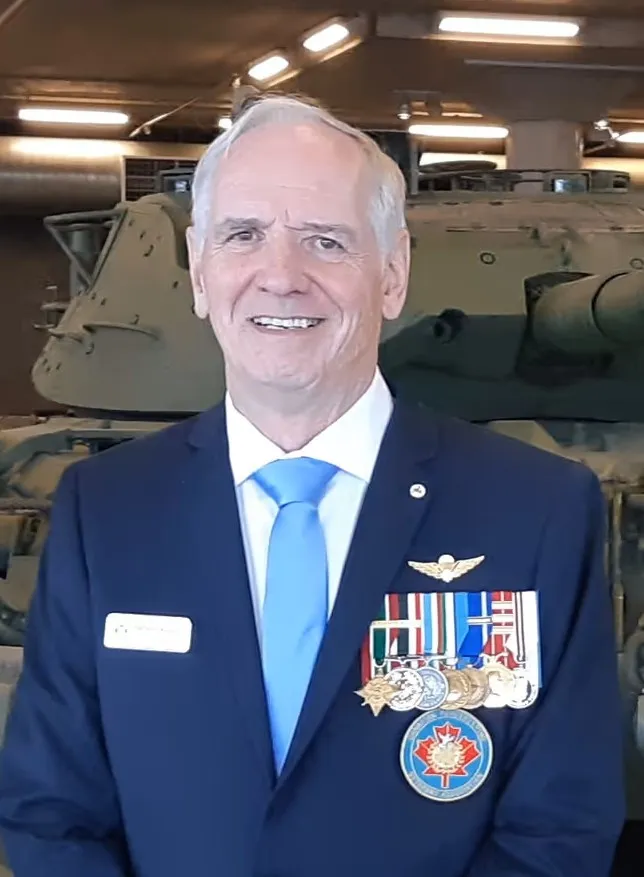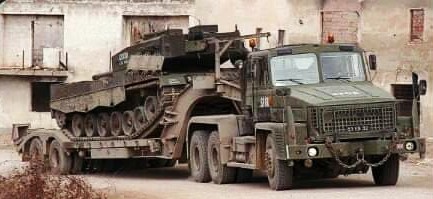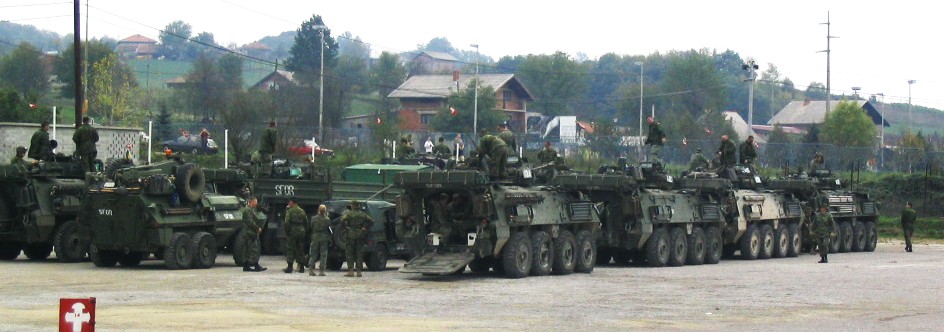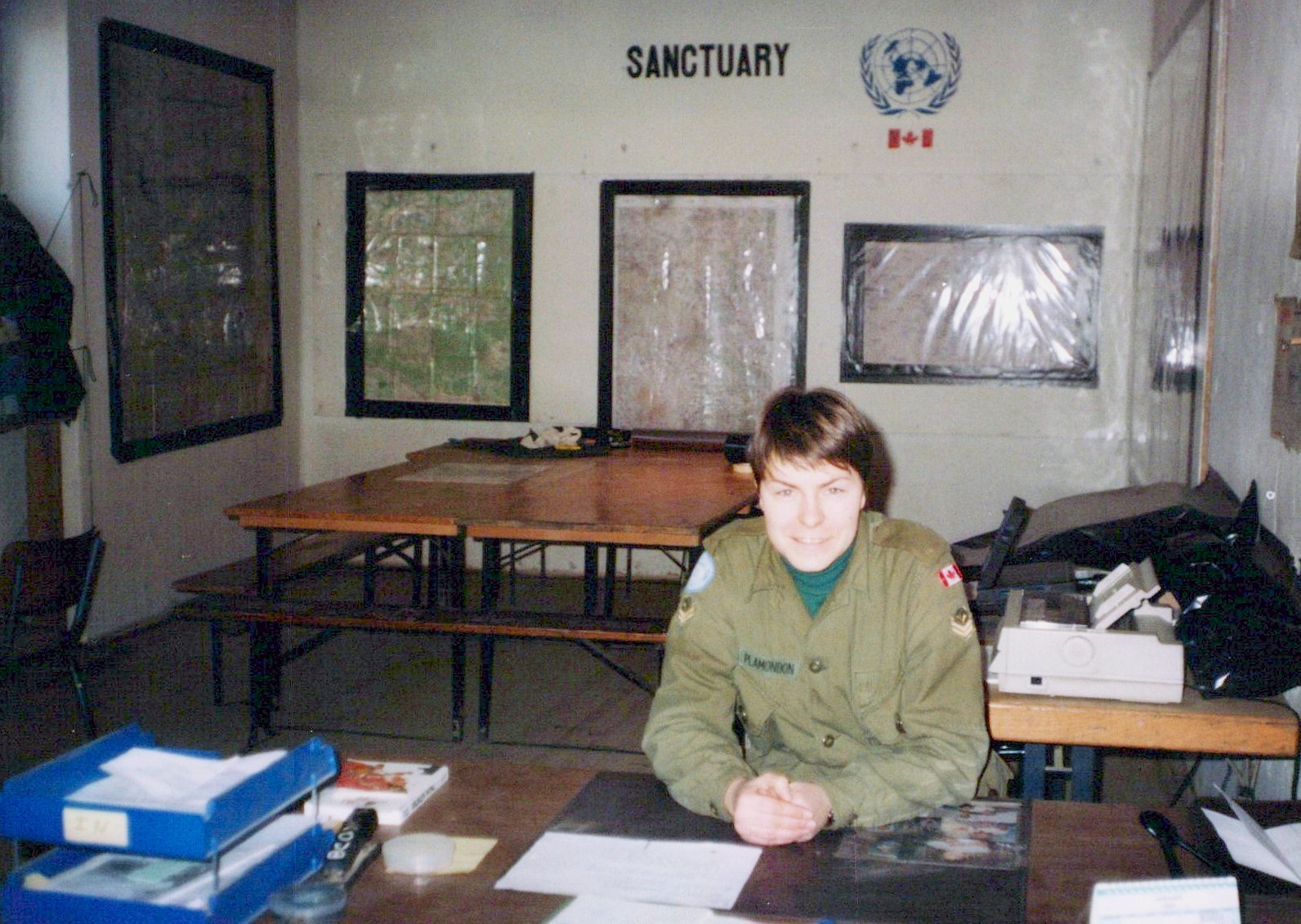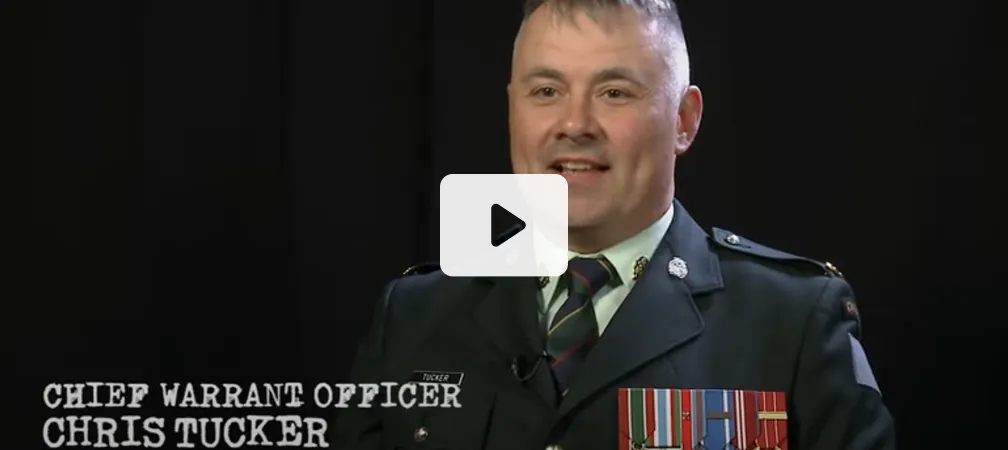SFOR, Bosnia-Herzegovina, 1997, Major (Retired) Harold Skaarup
WARNING: Due to the nature of the conflict and operations in the Balkans, some of these veterans' stories may contain graphic or disturbing content. Please use your discretion. If a story adversely affects your mental health, consider seeking help by consulting the agencies listed in the Resources section of this website.
Sarajevo, Bosnia-Herzegovina, 1997
SFOR, CANIC
Notes from my tour of duty as Commanding Officer of the Canadian National Intelligence Centre (CANIC) with the Canadian Contingent of the NATO led Peace Stabilization Force (CC SFOR) in Sarajevo, Bosnia-Herzegovina from 21 June to 30 December 1997.
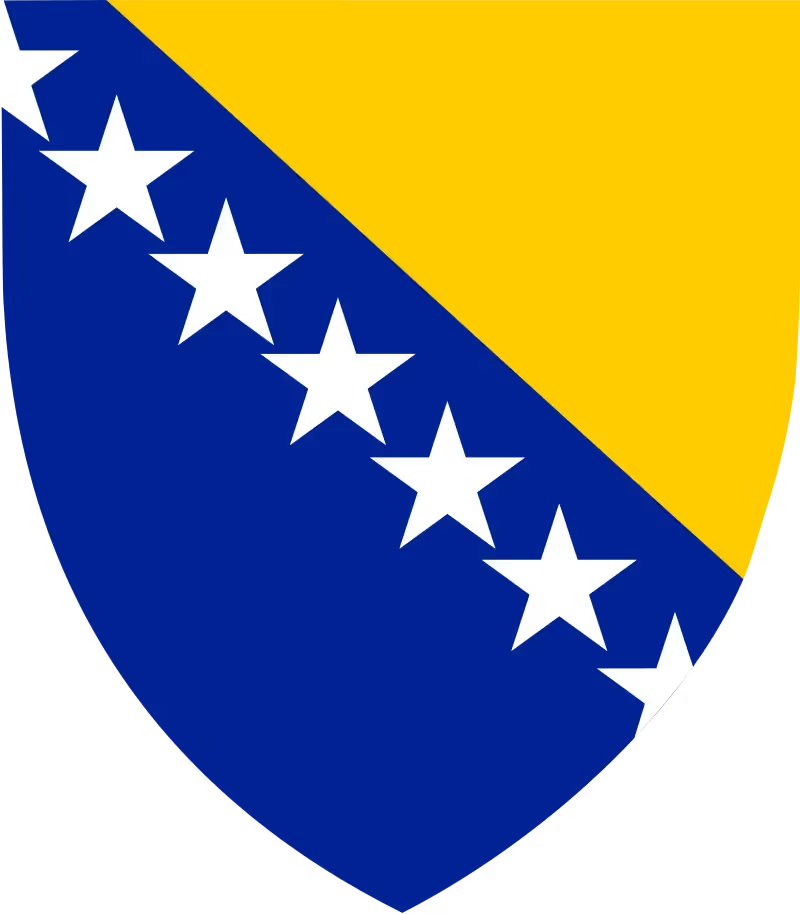
BiH Coat of Arms
Bosnia and Herzegovina, abbreviated BiH or B&H, sometimes called Bosnia–Herzegovina stands in Southeast Europe, located within the Balkans, with Sarajevo as its capital and largest city.
Bosnia and Herzegovina is bordered by Serbia to the east, Montenegro to the southeast, and Croatia to the north and southwest. In the south it has a narrow coast on the Adriatic Sea, which is about 20 kilometres (12 miles) long and surrounds the town of Neum. The inland Bosnia region has a moderate climate, with hot summers and cold, snowy winters. In the central and eastern interior of the country the geography is mountainous, in the northwest moderately hilly, and in the northeast predominantly flatland. The smaller southern region, Herzegovina, has a Mediterranean climate and mostly mountainous topography.
Bosnia and Herzegovina has been settled since at least the Upper Paleolithic but permanent human settlement traces back to the Neolithic age, during which time it was inhabited by cultures such as Butmir, Kakanj, and Vu?edol. After the arrival of the first Indo-Europeans, it was populated by several Illyrian and Celtic civilizations. Culturally, politically, and socially, the country has a rich but complex history, having been first settled by the South Slavic peoples that populate the area today from the 6th through to the 9th centuries. In the 12th century the Banate of Bosnia was established, which evolved into the Kingdom of Bosnia in the 14th century, after which it was annexed into the Ottoman Empire, under whose rule it remained from the mid-15th to the late 19th cenries. The Ottomans brought Islam to the region, and altered much of the cultural and social outlook of the country. This was followed by annexation into the Austro-Hungarian Monarchy,, which lasted up until the First World War. In the interwar period, Bosnia and Herzegovina was part of the Kingdom of Yugoslavia and after the Second World War, it was granted full republic status in the newly formed Socialist Federal Republic of Yugoslavia. Following the dissolution of Yugoslavia, the republic proclaimed independence in 1992, which was followed by the Bosnia War, lasting until late 1995 and culminating with the Dayton Agreement.
The country is home to three main ethnic groups or, officially, constituent peoples, as specified in the constitution. Bosniaks are the largest group of the three, with Serbians second, and Croatians third. A native of Bosnia and Herzegovina, regardless of ethnicity, is usually identified in English as a Bosnians. Minorities include Jews, Roma, Ukranians and Turks. Bosnia and Herzegovina has a bicameral legislature and a three-member Presidency composed of a member of each major ethnic group. However, the central government's power is highly limited, as the country is largely decentralized and comprises two autonomous entities: the Federation of Bosnia and Herzegovina (BiH) and Republika Srpska (RS), with a third unit, the Br?ko District, governed under local government. The Federation of Bosnia and Herzegovina consists of 10 cantons.
Bosnia and Herzegovina is a developing country with an economy dominated by the industry and agriculture sectors, followed by the tourism and service sectors, the former of which has seen a significant rise in recent years. The country has a social security and universal healthcare system, and primary- and secondary-level education is tuition-free.
The Bosnian War, 1992 - 1995
On 18 November 1990, multi-party parliamentary elections were held throughout Bosnia and Herzegovina. A second round followed on 25 November, resulting in a national assembly where communist power was replaced by a coalition of three ethnically-based parties. Following Slovenia and Croatia's declarations of independence from Yugoslavia, a significant split developed among the residents of Bosnia and Herzegovina on the issue of whether to remain within Yugoslavia (overwhelmingly favored by Serbs) or seek independence (overwhelmingly favored by Bosniaks and Croats).
The Serb members of parliament, consisting mainly of the Serb Democratic Party members, abandoned the central parliament in Sarajevo, and formed the Assembly of the Serb People of Bosnia and Herzegovina on 24 October 1991, which marked the end of the tri-ethnic coalition that governed after the elections in 1990. This Assembly established the Serbian Republic of Bosnia and Herzegovina in part of the territory of Bosnia and Herzegovina on 9 January 1992. It was renamed Republika Srpksa in August 1992. On 18 November 1991, the party branch in Bosnia and Herzegovina of the ruling party in the Republic of Croatia, the Croatian Democratic Union (HDZ), proclaimed the existence of the Croatian Community of Herzog-Bosnia in a separate part of the territory of Bosnia and Herzegovina with the Croatian Defence Council (HVO) as its military branch. It went unrecognized by the Government of Bosnia and Herzegovina, which declared it illegal.
A declaration of the sovereignty of Bosnia and Herzegovina on 15 October 1991 was followed by a referendum for independence on 29 February/1 March 1992, which was boycotted by the great majority of Serbs. The turnout in the independence referendum was 63.4 percent and 99.7 percent of voters voted for independence. Bosnia and Herzegovina declared independence on 3 March 1992 and received international recognition the following month on 6 April 1992. The Republic of Bosnia and Herzegovina was admitted as a member state of the United Nations on 22 May 1992. Serbian leader Slobodan Miloševiše and Croatian leader Franjo Tubman are believed to have agreed on a partition of Bosnia and Herzegovina in March 1991, with the aim of establishing Greater Serbia and Greater Croatia.
Following Bosnia and Herzegovina's declaration of independence, Bosnian Serb militias mobilized in different parts of the country. Government forces were poorly equipped and unprepared for the war. International recognition of Bosnia and Herzegovina increased diplomatic pressure for the Yugoslave People's Army (JNA) to withdraw from the republic's territory, which they officially did in June 1992. The Bosnian Serb members of the JNA simply changed insignia, formed the Army of Republika Srpska (VRS), and continued fighting. Armed and equipped from JNA stockpiles in Bosnia, supported by volunteers and various paramilitary forces from Serbia, and receiving extensive humanitarian, logistical and financial support from the Federal Republic of Yugoslavia, Republika Srpska's offensives in 1992 managed to place much of the country under its control. The Bosnian Serb advance was accompanied by the ethnic cleansing of Bosniaks and Bosnian Croats from VRS-controlled areas. Dozens of concentration camps were established in which inmates were subjected to violence and abuse, including rape. The ethnic cleansing culminated in the Srebrenica massacre of more than 8,000 Bosniak men and boys in July 1995, which was ruled to have been a genocide by the ICTY. Bosniak and Bosnian Croat forces also committed war crimes against civilians from different ethnic groups, though on a smaller scale. Most of the Bosniak and Croat atrocities were committed during the Bosniak-Croat war, a sub-conflict of the Bosnian War that pitted the Army of the Federation of Bosnia and Herzegovina (ARBiH) against the HVO. The Bosniak-Croat conflict ended in March 1994, with the signing of the Washington Agreement, leading to the creation of a joint Bosniak-Croat Federation of Bosnia and Herzegovina, which amalgamated HVO-held territory with that held by the ARBiH.
The Dayton Accord and the Implementation Force (IFOR)

The General Framework Agreement for Peace, commonly known as the Dayton Peace Accord, was signed in December 1995. To ensure compliance with this agreement, the UN Security Council adopted a resolution which authorized the establishment of a multinational peace implementation force (IFOR). IFOR was sent to maintain cease-fire and inter-entity boundary lines. Its mission was also to foster a secure environment in which civilian organizations could carry out their responsibilities, which included the supervision of elections, the coordination of the return of refugees, economic recovery and monitoring and training of local police. Without the assistance of IFOR, the peace agreements would not have endured, nor would the civilian aspects of the Dayton Peace Accord have been achieved.
Canadians in Bosnia-Herzegovina, IFOR
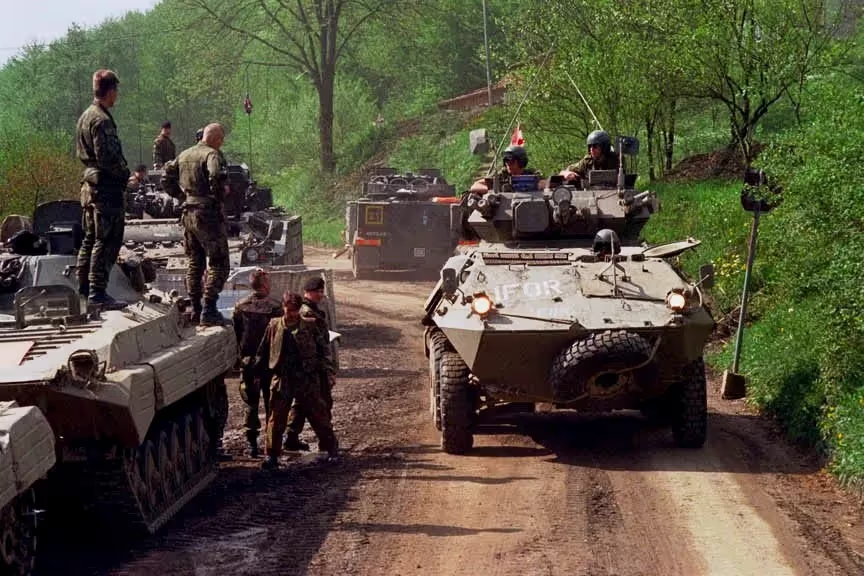
(DND Photo)
Canadian AVGP Cougar, IFOR, on patrol during Operation ALLIANCE.
Canada contributed CF members to IFOR under the name Operation ALLIANCE. This operation had 1,047 personnel in a composite organization that consisted of a Canadian-led Multinational Brigade Headquarters, a reconnaissance squadron, a mechanized infantry company, an engineer squadron, as well as a Canadian National Command Element and National Support Element.
In addition to the provision of brigade headquarters and signals personnel for IFOR’s multinational brigade (2 Canadian Multinational Brigade and, later, 5 Canadian Multinational Brigade), the CF deployed an armoured reconnaissance squadron, an infantry company, an engineer squadron, a national support element, an advanced surgical centre and a military police platoon.
The first Canadian infantry battle group deployed was drawn from units based in Petawawa, Ontario, and Gagetown, New Brunswick, while the second came from Valcartier, Quebec. Their tasks included establishing freedom of movement throughout the area of operations, supervising the withdrawal and separation of the previously warring factions and their heavy weapons, patrolling cease fire lines, supervising the removal of land mines and unexploded ordnance, settling disputes and helping with the redeployment of UN personnel and equipment still in Bosnia-Herzegovina.
Canadian sailors and air force personnel also served in support of IFOR as part of the ongoing maritime blockade (NATO Operation SHARP GUARD) and enforcement of the “no-fly zone” (NATO Operation DECISIVE ENDEVOUR) in the region.
On 20 December 1996, one year after the creation of IFOR, a NATO-led Stabilization Force (SFOR) replaced IFOR.
Canadians in Bosnia-Herzegovina, SFOR
In December of 1996, when the IFOR phase ended, a stabilization force (SFOR) was created in order to secure the environment for local authorities and international agencies. The troops of SFOR patrolled Bosnia-Herzegovina so that people could go about their daily business without fear. Part of a major international effort to help Bosnia-Herzegovina reshape itself as a democratic European nation, SFOR had a mandate to deter violence and provide the safe, secure environment needed for the consolidation of peace in Bosnia-Herzegovina. Its goal was to promote a climate in which the peace process could be sustained without the presence of NATO forces.
Canada's participation in SFOR, conducted under Operation PALLADIUM, began with approximately 1,200 personnel: an infantry battalion group with tactical helicopter support; an armoured reconnaissance squadron; an engineer squadron; an administrative company; a National Support Element; and a National Command Element.
In December of 2003, due to a vast improvement of the security situation in Bosnia, NATO announced the reduction in the number of SFOR troops from 12,000 to 7,000 by June 2004. In keeping with NATO direction, Canada's military participation was similarly reduced to about 650 CF members in April 2004.
The Stabilisation Force in Bosnia and Herzegovina (SFOR) was a NATO-led multinational peacekeeping force deployed to Bosnia and Herzegovina after the Bosnian war. Although SFOR was led by NATO, several non-NATO countries contributed troops. It was replaced by EUFOR Operation ALTHEA in December 2004. The stated mission of SFOR was to "deter hostilities and stabilize the peace, contribute to a secure environment by providing a continued military presence in the Area Of Responsibility (AOR), target and co-ordinate SFOR support to key areas including primary civil implementation organisations, and progress towards a lasting consolidation of peace, without further need for NATO-led forces in Bosnia and Herzegovina".
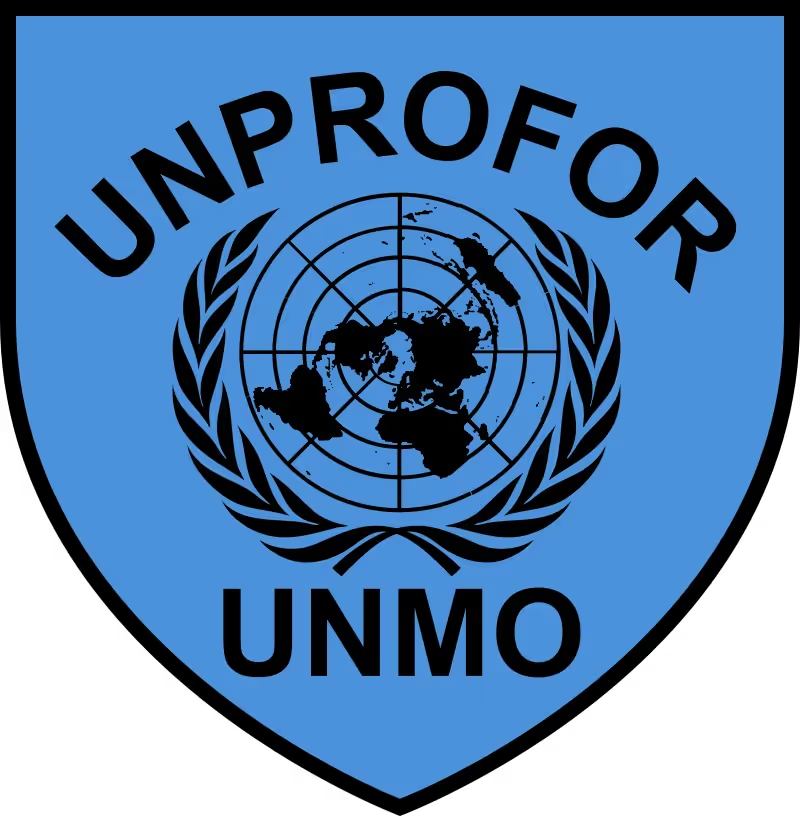
In response to the growing security threat caused by the civil war in the former Yugoslavia, the UN Security Council authorized the creation of the United Nations Protection Force (UNPROFOR) in 1992. Its mission was to protect non-combatants and to ensure the security and demilitarization of UN protected areas in Croatia. UNPROFOR was also responsible for ensuring the security and functioning of the airport at Sarajevo, delivering humanitarian assistance in Sarajevo and throughout Bosnia-Herzegovina, protecting convoys of released civilian detainees, monitoring the "no-fly" zone in Bosnia-Herzegovina and monitoring the border areas of the Former Yugoslav Republic of Macedonia. Canada contributed CF members to UNPROFOR and United Nations Peace Forces Headquarters (UNPF) between April 1992 and December 1995 under the names Operation HARMONY and Operation CAVALIER.
UNPROFOR was composed of nearly 39,000 personnel. It was composed of troops from Argentina, Australia, Bangladesh, Belgium, Brazil, Canada, Colombia, Czech Republic, Denmark, Egypt, Estonia, Finland, France, Germany, Ghana, India, Indonesia, Ireland, Italy, Jordan, Kenya, Lithuania, Luxembourg, Malaysia, Nepal, Netherlands, New Zealand, Nigeria, Norway, Pakistan, Poland, Portugal, the Russian Federation, Slovak Republic, Spain, Sweden, Switzerland, Tunisia, Turkey, Ukraine, the United Kingdom and the United States. According to the UN, there were 167 fatalities amongst UNPROFOR personnel during the course of the force's mandate. Of those who died, three were military observers, 159 were other military personnel, one was a member of the civilian police, two were international civilian staff and two were local staff.
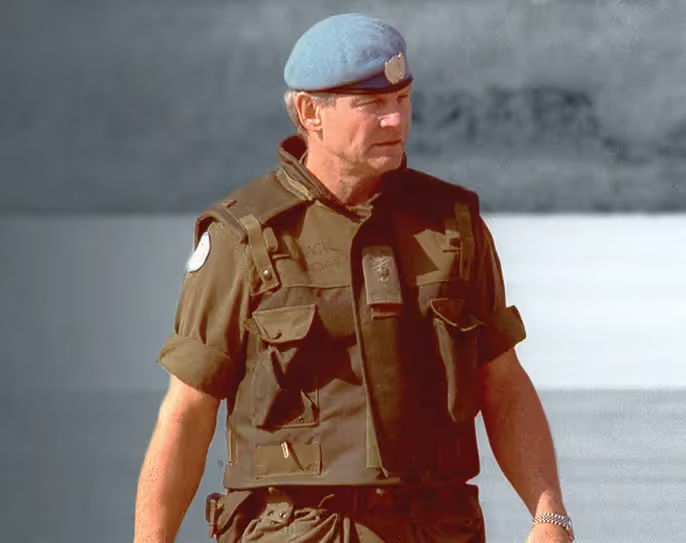
(DND Photo)
Major-General Lewis MacKenzie (Canada) was named chief of staff of the United Nations peacekeeping force in former Yugoslavia in February 1992. Although the purpose of the mission was to ensure a cease-fire in newly independent Croatia, the UN headquarters were located in the Bosnian capital, Sarajevo. Soon after the Republic of Bosnia and Herzegovina was created, MGen MacKenzie found himself in the midst of warring ethnic factions. In May 1992 he created Sector Sarajevo and with his UN force set about opening the Sarajevo airport for the delivery of humanitarian aid. MGen MacKenzie used the only weapon at his disposal, the media, to try to help restore peace.
After his return from the Balkans in October 1992, MGen MacKenzie was appointed commander of the army in Ontario. However, the conflict in former Yugoslavia followed him back to Canada. He was verbally attacked by members of the Croatian community in Canada and by factions in Bosnia. Although he tried to defend himself, as a member of the Canadian armed forces he was precluded from commenting on government policy. After criticizing the United Nations’ inability to command, control, and support its peacekeeping forces, MGen MacKenzie retired from the military in March 1993. That year he published an account of his career, Peacekeeper: The Road to Sarajevo, in which he recounted his harrowing experiences. In 1993 the Conference of Defence Associations Institute presented MacKenzie with its Vimy Award, and in 2006 he was awarded the Order of Canada.
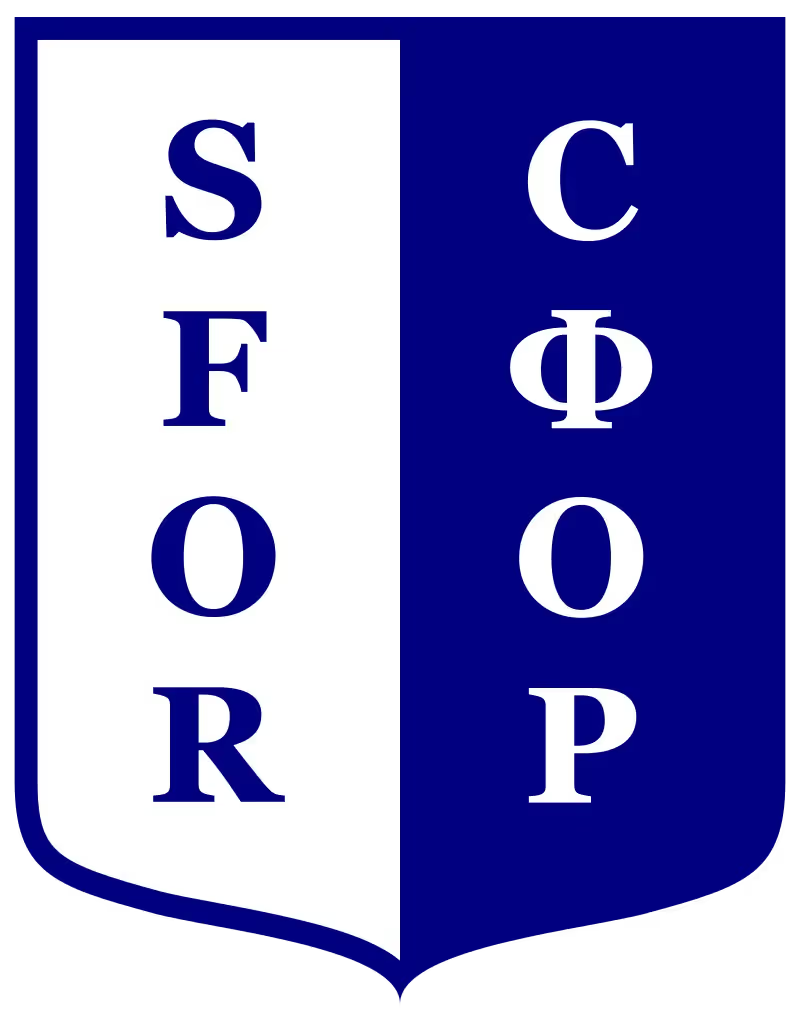
SFOR was divided into three zones of operation:
Mostar MND(S) – Italian, Franco-German, Spanish; Banja Luka MND(W) – American, British, Canadian, Czech, Dutch. The British code name for their activities in IFOR was Operation RESOLUTE and SFOR was Operation LODESTAR (to June 1998) and Operation PALATINE (from Jun 1998). The Canadian mission was named Operation PALLADIUM (1996 to 2004). Tuzla MND(N) – American, Turkish, Polish, Russian, Norwegian, Swedish, Danish. (Some units had troops stationed outside the assigned zone). The three Areas of Operation (AO) were known collectively as Multi-National Divisions (MND) until the end of 2002 where they were reduced in scope to Multi-National Brigades.
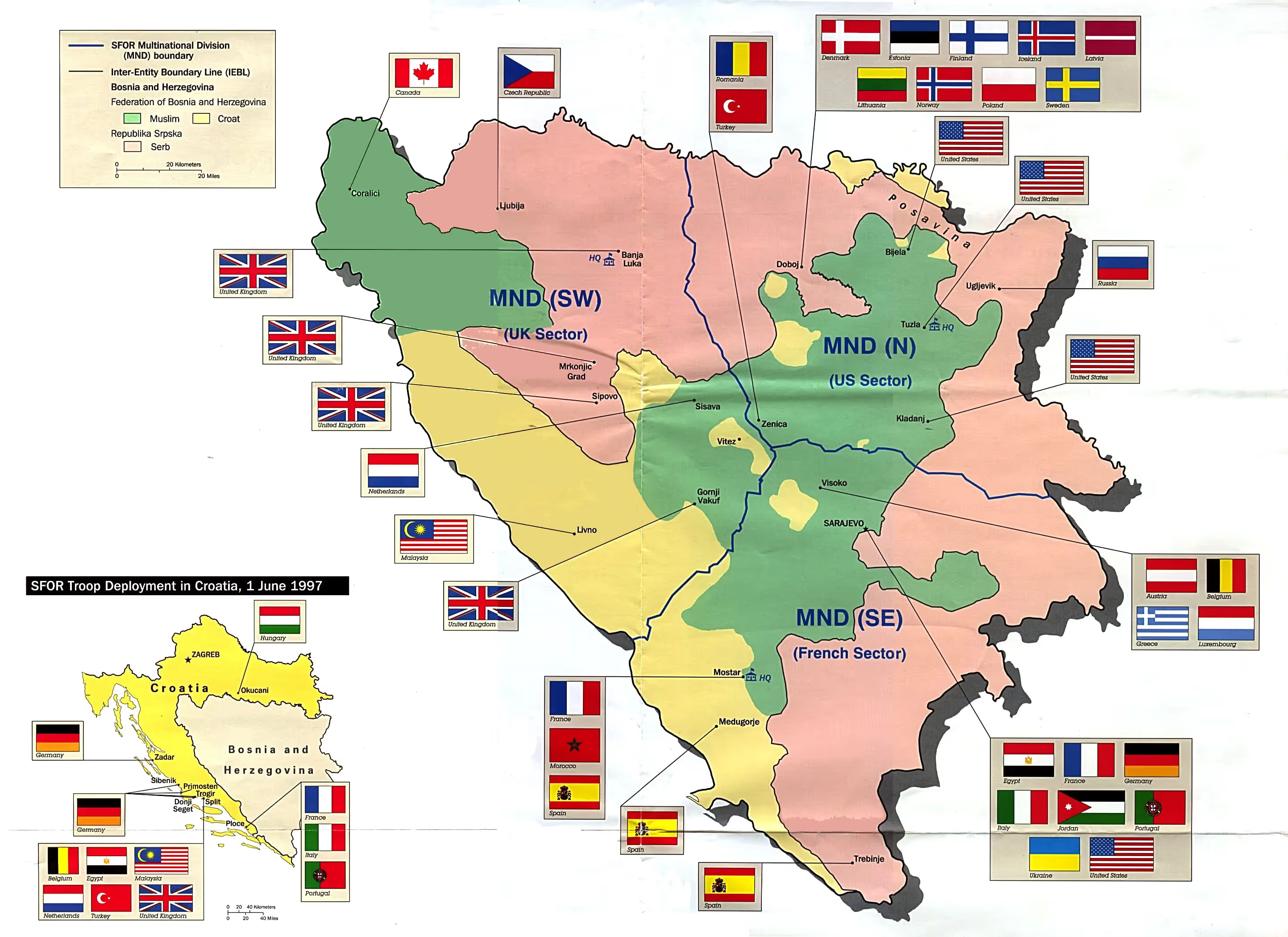
Troops deployments in BiH, 1997.
SFOR operated under peace enforcement, not peacekeeping, rules of engagement. For example, it was cleared, in 1997, to neutralise Serb radio-television facilities. During its mandate, SFOR arrested 29 individuals who were charged with war crimes. Those arrested were transferred to the International Criminal Tribunal for the Former Yugoslavia in the Netherlands.
In February 1994, a Bosnia-Herzegovina Serb mortar attack on a Sarajevo market place killed 66 people and injured another 200. (At least that is how the incident was reported, although it is suspected that the Bosniaks fired the mortar on themselves to gain international sympathy). This act prompted NATO to threaten punitive bombing if the Serbs did not pull back from the city as directed. It is considered the day the Bosniaks “acquired an Air Force (NATO).” The Bosnia-Herzegovina Serbs then kidnapped UN Peacekeepers and used them as human shields to halt NATO air strikes. (One of these human shields was one of our Arms Verification Inspectors, Capt Pat Rechner).
In May 1995, NATO launched two days of air strikes in an effort to break a Serb blockade of Sarajevo. Bosnia-Herzegovina Serbs seized 400 UN peacekeepers and chained them to possible bombing targets to forestall further attacks. The hostages were gradually released throughout May and June. In July, the Bosnia-Herzegovina Serbs overran the UN safe areas of Srebrenica and Zepa and massacred most of the population and ethnically cleansed the rest. In August 1995, NATO resumed air-strikes in response to the shelling of Sarajevo. A ceasefire was established in October. In November, negotiators for all sides in the Bosnia-Herzegovina conflict met at Wright-Patterson Air Force Base in Dayton, Ohio, for a three-week planning session to hammer out a workable peace plan. By December, British and American military personnel were arriving in Bosnia-Herzegovina to assist in the implementation of the agreement. Canadian Intelligence personnel were part of the Peace Implementation Force (IFOR) and its follow on, SFOR, from the beginning.
OP Alliance involved the deployment of IFOR to Bosnia-Herzegovina as authorized by SACEUR from G Day (16 Dec 95). IFOR’s forward HQ was located in Zagreb, with the ACE Reaction Corps (ARRC) HQ in the same location. The USA, the UK and France controlled three major zones. The 997-man Canadian Contingent initially came under the operational control of the Multi-National Division (MND) South West in the UK zone. Canada also provided an observer with the Organization for Security and Cooperation in Europe (OSCE), who was based in Sarajevo, and one Canadian Senior Staff Officer with UNMIBH, as well as 20 Canadian Forces personnel and 100 RCMP and civilian police from 1995 to 2000.
5 Canadian Multi-National Brigade (5 CAMNB) had its HQ located in Coralici (north of the town of Bihac), while the National Support Element (NSE) was located in the town of Kljuc. One Canadian served as an UNMO in Montenegro, and another served in Macedonia.
In 1995, Croatia‘s President Tudjman allowed the UN peacekeeping mandate to lapse, and he renewed his region’s battles with the Croatian Serbs. In August, Croatian Troops regained the territory in the Krajina region that had been lost to Croatian Serbs in 1991. In 1996, Sarajevo was handed over to the Bosnia-Herzegovina-Croat Federation. Public pressure forced the withdrawal of Radovan Karadzic, although he continued to direct political and criminal activities from his residence in Pale. IFOR became SFOR (Stabilization Force) in Bosnia-Herzegovina-Herzegovina.
In 1996, within the Implementation Force (IFOR), there were approximately 52,000 Troops from NATO countries and other participating signatories. Their mandate was to enforce the military aspects of the Dayton Peace Accord.
In 1997, the bulk of the 1,300 Canadian forces in Bosnia are located in Coralici and Velika Kladusa, with about 50 personnel in the Sarajevo area, including the six in the CANIC.
Ćoralići (Serbian: Ћоралићи) is a village in the municipality of Cazin, Bosnia and Herzegovina. According to the 2013 census, its population was 2,665.
Velika Kladuša (Serbian Cyrillic: Велика Кладуша, "Great Kladuša") is a town in the Una-Sana Canton, Bosnia and Herzegovina. It is situated in the far northwest of Bosnia, located on the border with Croatia. In 2013, it had a population of 40,419 inhabitants expanding over 331,73 km². Velika Kladuša is one of the most densely populated areas in Bosnia and Herzegovina.
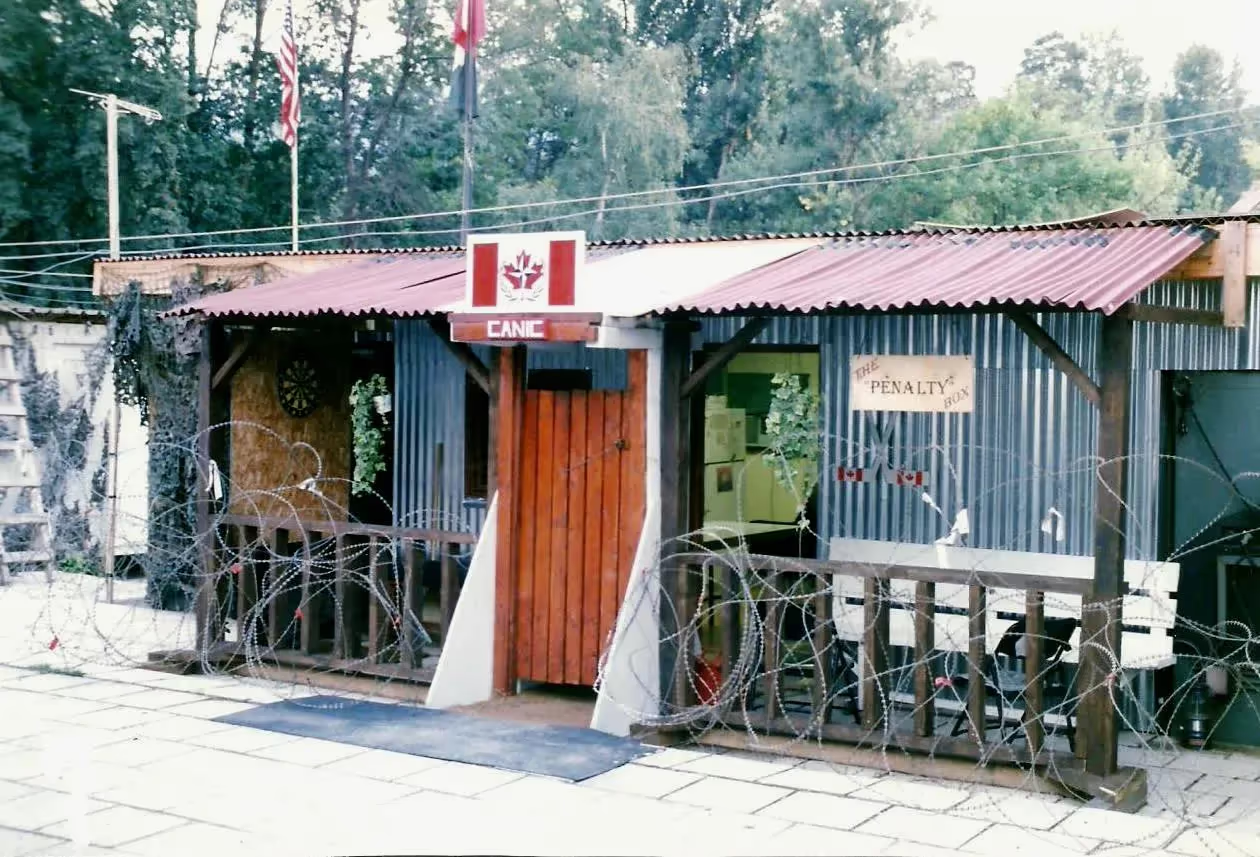
(Author Photo)
The Canadian National Intelligence Cell (CANIC) Sarajevo was established in Dec 1995 by the the Chief Operations Officer for the CF, the Deputy Chief of the Defence Staff (DCDS). The mission of the CANIC was to provide Intelligence support to NATO/IFOR through the HQ ARRC Main, the Commander Canadian Contingent in-theatre (CCIFOR), and to any national decision-making with regards to the Former Yugoslav Republic.
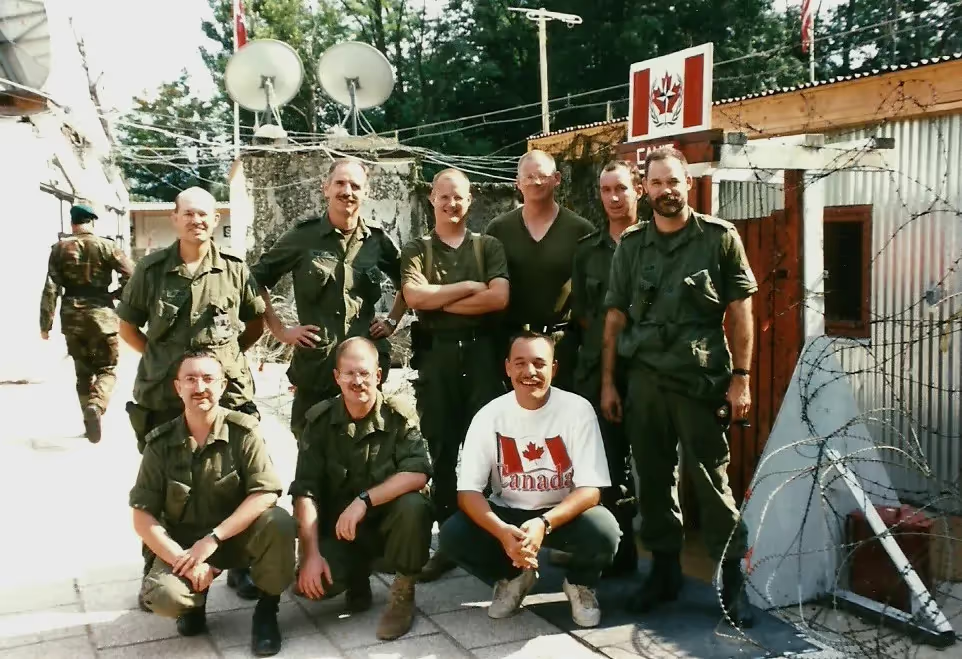
(DND Photo)
Canadian National Intelligence Centre (CANIC) crew in Sarajevo, ca June 1997.
Front row kneeling: Capt David B. Owen, MCpl Ian Steel, PO André Gibeault. Rear row standing: WO R. Hal Pugh, Maj Harold A. Skaarup, Sgt Michael C. Wagner, WO Byron K. Mackenzie, Capt Al Haywood, PO1 William D. Kean. All of us were serving, with the NATO-led Peace Stabilization Force (SFOR), in 1997.
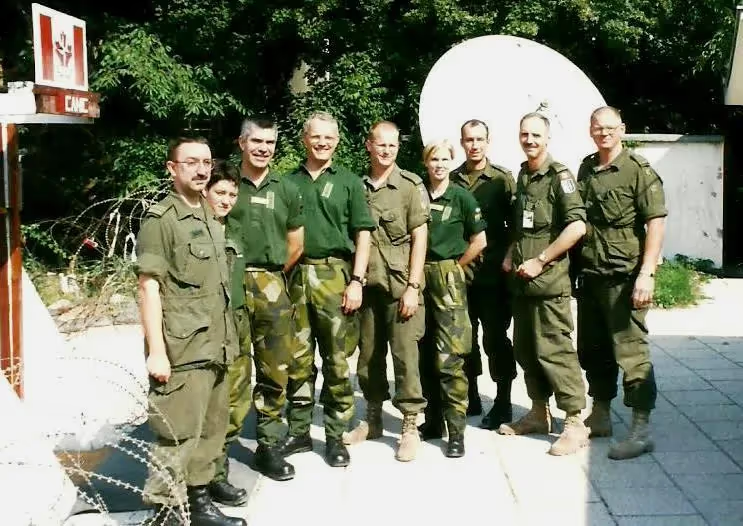
SWENIC and CANIC crews, Sarajevo, July 1997. CA Capt Dave Owens, SW translator, SW Capt Haakon Schuessler, SW LCol Kjell (Shell) Ericsson, SW Sgt 1st Class Karen Berlin, CA Capt Allan Haywood, CA Maj Hal Skaarup, CA WO Byron K. Mackenzie.

US, US, CA Maj Hal Skaarup, US, CA Capt Al Haywood, US Maj, US Maj.
UK GCHQ LO Dewi Blythe, WO Byron MacKenzie, UK Llewlyn, analyst with a Welsh dragon flag on his shoulder, US, US LCdr Larry Ash, CO of the USNIC.

(Tomasino Photo)
SFOR headquarters in Sarajevo, Bosnia and Herzegovina in 1997.
While the European Union assumed responsibility for peacekeeping operations when SFOR was brought to a successful end in November 2004, NATO established a headquarters in Sarajevo to assist the country with defence reform. Under Op BRONZE, Canadian Forces personnel served in various staff positions at NATO Headquarters Sarajevo (NHQSa). The primary focus of NHQSa is defence reform. NHQSa also undertakes certain operational tasks, including counter-terrorism and support to the International Criminal Tribunal for the former Yugoslavia, with regard to the detention of persons indicted for war crimes, and intelligence sharing with the European Union. The closure of Op BRONZE occurred on 29 March 2010, after 19 years of CF operations in Bosnia-Herzegovina.
European Union Force (EUFOR)
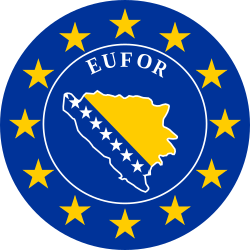
Following its summit meeting in Istanbul on June 28, 2004, NATO announced that its operations in Bosnia-Herzegovina would be turned over to a European Union Force (EUFOR) by the end of 2004. During the fall of 2004, SFOR was gradually reduced while EUFOR was built up to replace it. As part of the wider transition process, and in concert with our NATO and European allies, the Canadian contingent in SFOR was reduced in early October 2004 from 650 to less than 85 CF members. This decrease marked the start of Operation BRONZE, the last phase of the CF contribution to SFOR, and the start of Operation BOREAS, Canada’s contribution to EUFOR.
Operation BOREAS was comprised of a CF Liaison and Observation Team (LOT). The primary task of the LOT was to provide information and situational awareness to EUFOR by maintaining close contact with local authorities, including mayors, police forces, border patrols, community leaders and Bosnian Army Units. The LOT also assisted in supporting the rule of law in general, most notably, preventing smuggling and the collecting of illegal weapons for destruction. As with all international operations, the Government of Canada reviews its commitments abroad on a regular basis. The decision to terminate Operation BOREAS in March 2007 coincided with an overall draw down of EUFOR personnel that took place due to the relative stability in the Balkan region.

(Author Photo)
The apartment blocks across from the airport probably suffered the most damage of any residential area in the city. The shell holes through the apartment blocks go on for kilometres. On the other side of the mountain there is no sign of battle damage. It is all farmland owned by the Serbs.

(Author Photo)
The wrecked newspaper building, downtown Sarajevo.
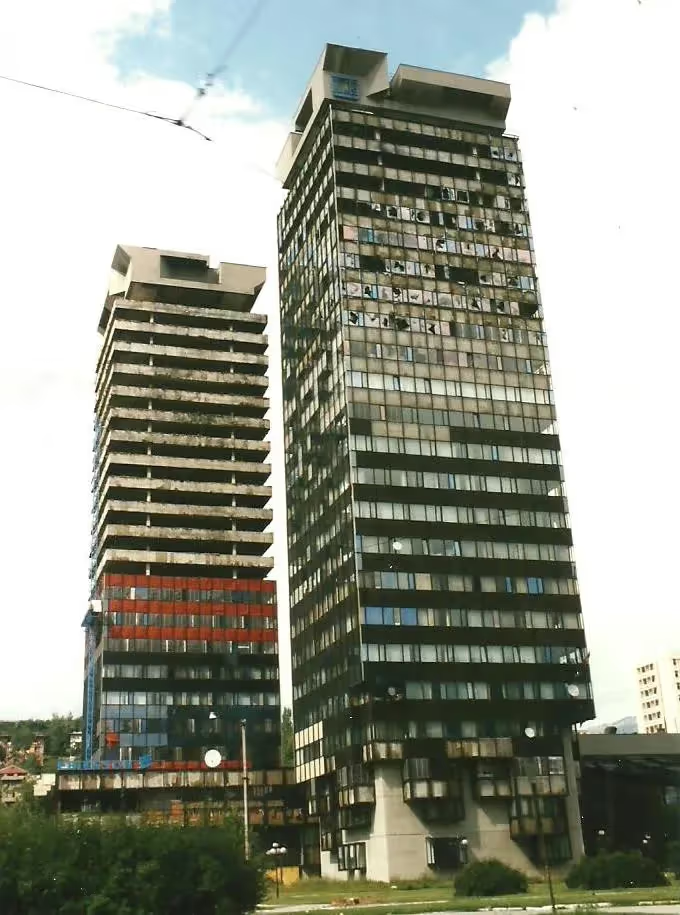
(Author Photo)
In 1997, the remains of the war damage was evident everywhere, with 20 and 30 story buildings burned out or partially gutted, while some of the stages were under repair. The newspaper office seemed to be the most heavily damaged (and photographed), because it had been on the front line and took a lot of serious hits from tank rounds. Shell strikes on most of the buildings were also evident everywhere.

The first page of the edition of the Domenica del Corriere, an Italian paper dated 12 July 1914, with a drawing of Achille Beltrame depicting Gavrilo Princip killing Archduke Francis Ferdinand of Austria in Sarajevo on 28 June 1914.
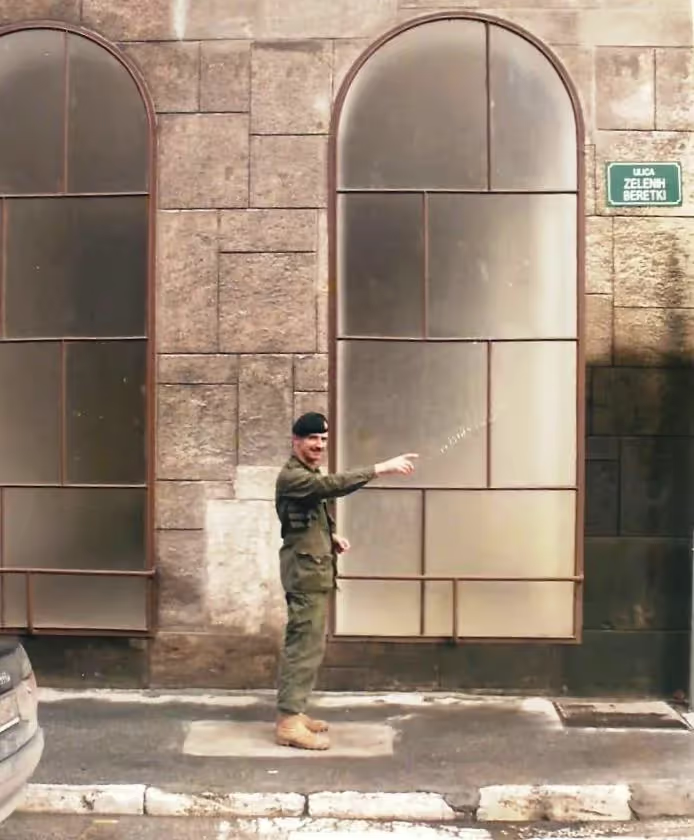
Author standing by the site where Gavrilo Prinzip shot the Archduke on 28 June 1914. His footprints and the plaque marking the site were eradicated later (he had been a Serb, and the Muslims were decidedly unhappy with the treatment and shelling meted out to them during the war).

(Author Photo)
Crashed Ukrainian IL-76 Candid transport aircraft slumped on the end of the runway at the airport in Sarajevo.
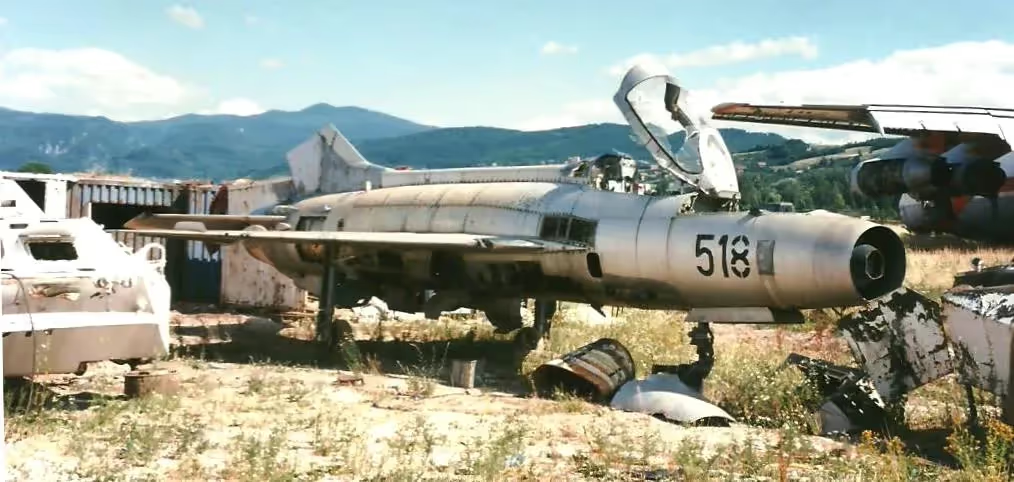
(Author Photo)
Remains of a wrecked MiG-21 Fishbed fighter (Serial No. 518) at Sarajevo airport. It was a lot smaller than I had thought. There were also wrecked UN BTR-70s and several other vehicles destroyed there, as well as a wrecked G-2 Galeb jet trainer and a Soko P-2 Kraguj light observation plane.

(Author Photo)
Norwegian Sisu AFV, guarding the entrance to Ilidza, Sarajevo.
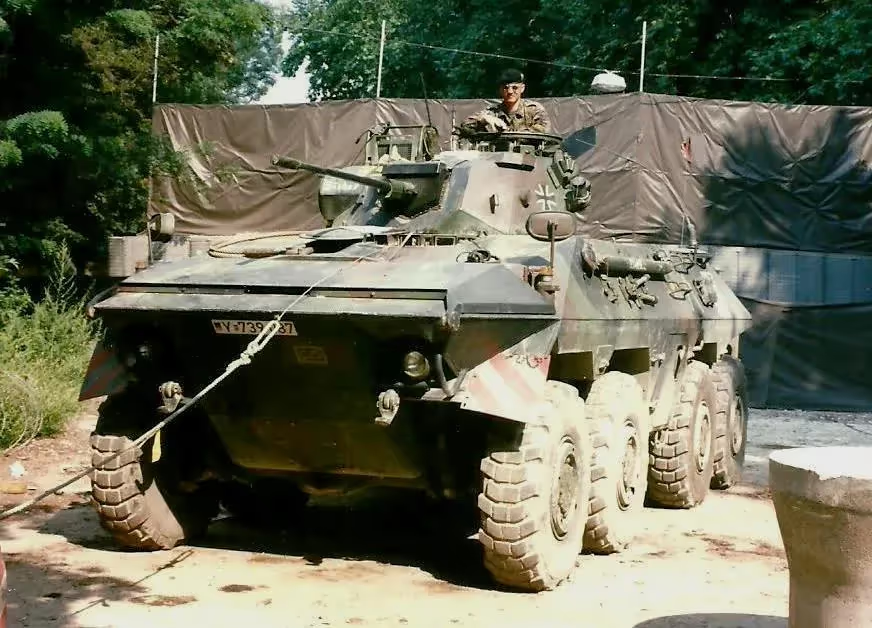
(Author Photo)
A German Luchs armoured vehicle guarding a bridge-crossing site.
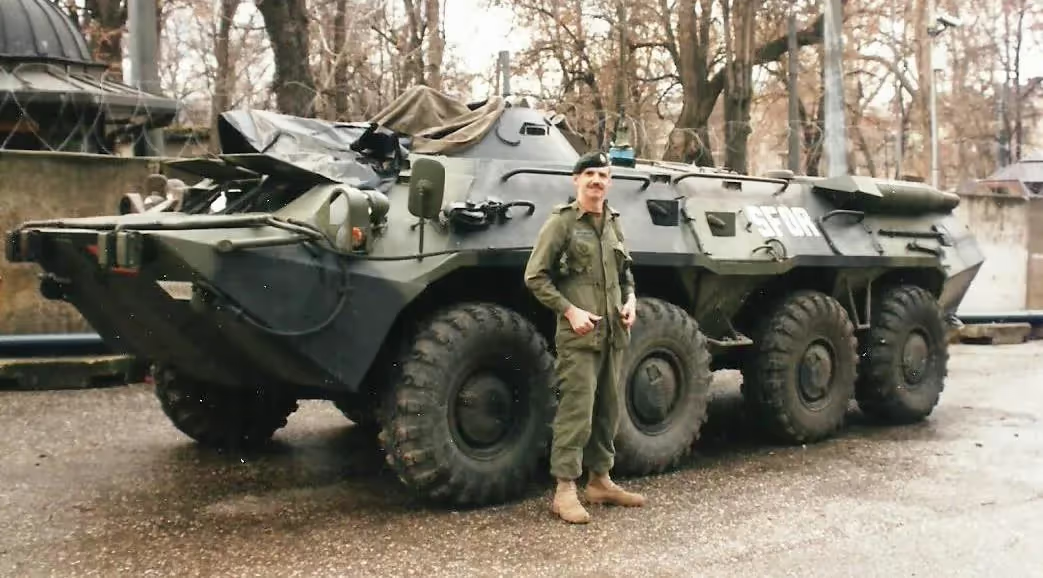
(Author Photo)
Author with a Turkish BTR-80 guarding a checkpoint in Sarajevo.
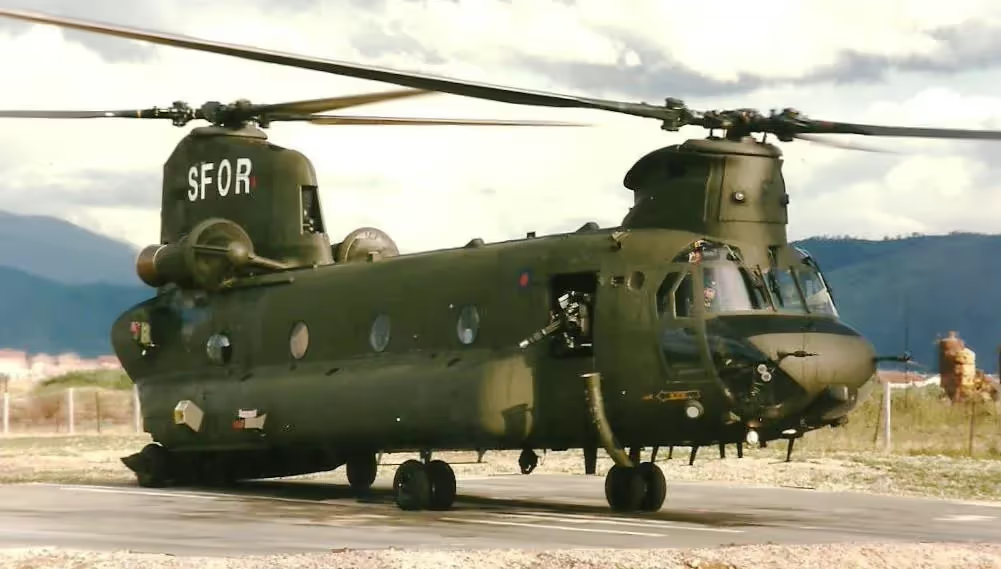
(Author Photo)
Boeing CH-47 Chinook twin-engined, tandem rotor, heavy-lift helicopter developed by American rotorcraft company Vertol and manufactured by Boeing Vertol. The CH-47 is among the heaviest lifting Western helicopters. Its name, Chinook, is from the Native American Chinook people of Washington state.
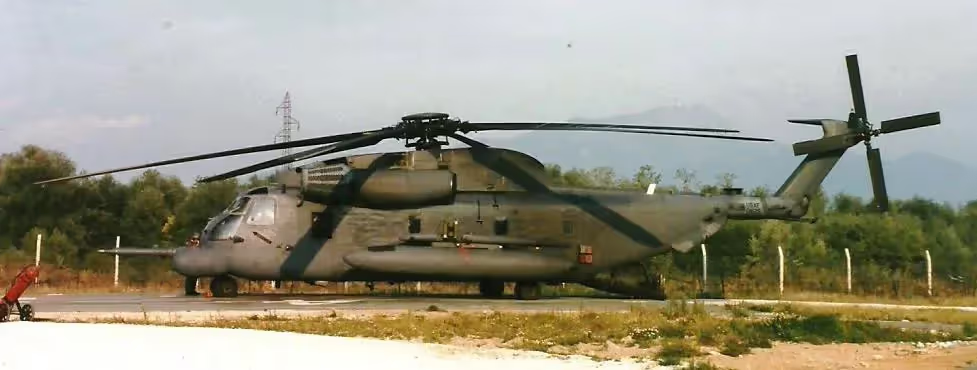
(Author Photo)
Sikorsky CH-53 Sea Stallion heavy-lift transport helicopter, Sarajevo.
Being located beside the helicopter landing pad, you became very quickly away when "something was up". On Thursday 10 Jul 97, the commander's morning video teleconference was very calm. At 0900 hours we had our three-eyes meeting in the UKNIC. During the discussions, a CH-47 Chinook helicopter lifted off from the helipad beside us, then a CH-53 Super Stallion lifted off behind it. These are all heavy lift helicopters, and very unusual to be here at the same time. Something was "up". LCdr Ash, the USNIC CO was pulled from the meeting. Shortly afterwards, Capt Eric Gjos called from the Canadian Battle Group in Coralici to give us a “heads up,” something is in the wind. Interesting so far...
About 0900 hours the SAS/SFOR moved to arrest Simo Drljaca, a Bosnian Serb Person Indicted for War Crimes (PIFWC) and former police chief of Prijedor in the RS. He pulled out a pistol and shot one of the British soldiers in the leg during the arrest. They promptly ventilated him with about five rounds, killing him on the spot. At the same time, another PIFWC, hospital director Milan Kovacevic as well as Drljaca’s brother in law and Drljaca’s son, were also seized and taken to the Hague for trial. Lots of intelligence activity. (Drljaca’s son and brother-in-law were released the next day). I visited the Canadian Embassy to meet with Kati Csaba and Guy Archambault for an interesting discussion. The senior OHR representative Mr Carlos Westendorp arrived just as I exited the Srbija/SFOR HQ. Lots of plain-clothes security personnel wearing earphones and carrying heavy weapons everywhere. We had the largest turnout of interested participants I’d seen to date at the 17:30 hrs Joint Operations Centre (JOC) conference. The mood in the UK/US community was very upbeat (unlike the 36 other nations in SFOR that felt they had been left out of the loop).
About this time I was called in to the senior Int Office and given a tasking - "take this package and brief a team on a specific mission - you won't know them, they won't know you, but make sure they get the details of the task. Be at the briefing location at o'dark x hours, and keep out of sight." I arrived late at night at the designated location and hovered around a small shed as out of the shadows a couple of soldiers made their way to the same location. One of them leaned in, and as he did, he said,.."are you...Hal, what the hell are you doing here?" I said, "Hi Mike, um, I'm meeting some people who have a job to do for my boss." Moment of silence. Mike and I had served as Captains with 4 Canadian Mechanized Brigade Group in Germany. "I guess that would be us", and we proceeded with the briefing. The team proceeded to carry out a successful operation.

(Author Photo)
Czech Mi-17 Hip helicopter, SFOR, Sarajevo.

(Author Photo)
FR Aérospatiale SA 330 Puma four-bladed, twin-engined medium transport/utility helicopter. The Puma was originally built by Sud Aviation of France, and continued to be made by Aérospatiale. SFOR, Sarajevo, 1997.
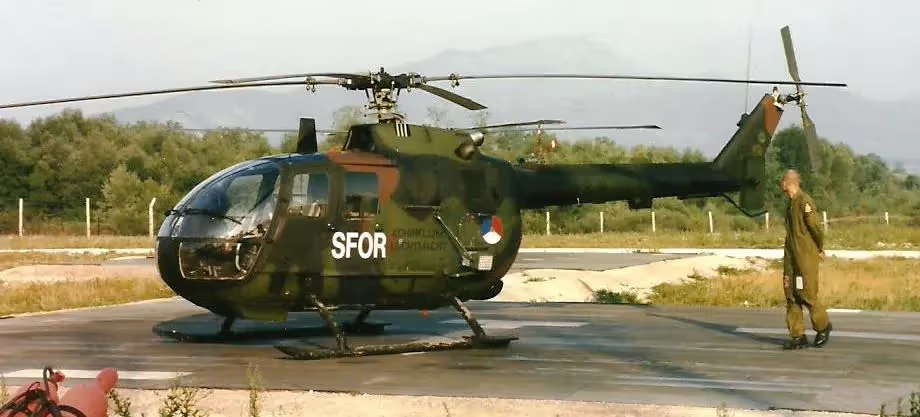
(Author Photo)
Netherlands BO-105 Helicopter, SFOR, Sarajevo.
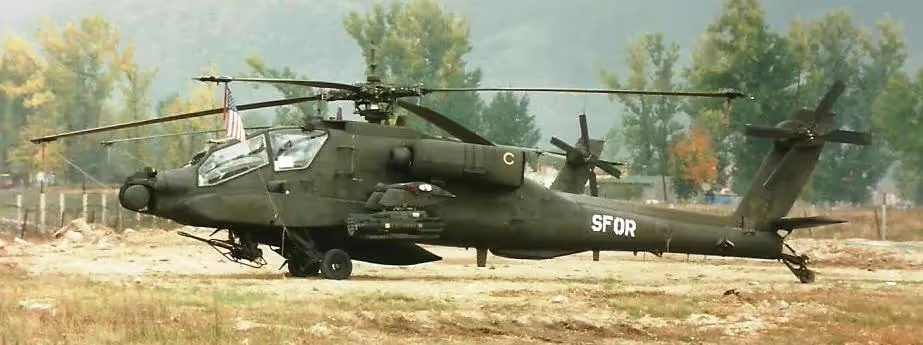
(Author Photo)
Boeing AH-64 Apache twin-turboshaft attack helicopter with a tailwheel-type landing gear arrangement and a tandem cockpit for a crew of two. It features a nose-mounted sensor suite for target acquisition and night vision systems. SFOR, Sarajevo.
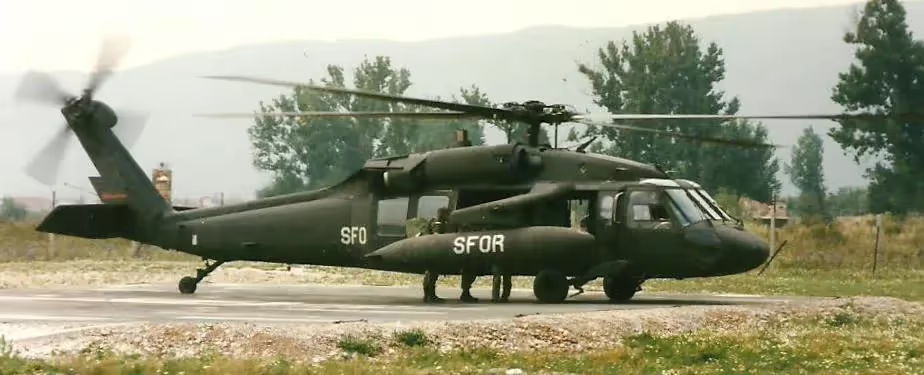
(Author Photo)
Sikorsky UH-60 Black Hawk four-blade, twin-engine, medium-lift utility helicopter, SFOR, Sarajevo.

(Author Photo)
Light Armoured Vehicle II (LAV II) Bison armoured personnel carrier (APC) based on the 8x8 LAV-25 platform produced by General Dynamics Land Systems (Canada) in London, Ontario. SFOR, Velika Kladusa, July 1997.
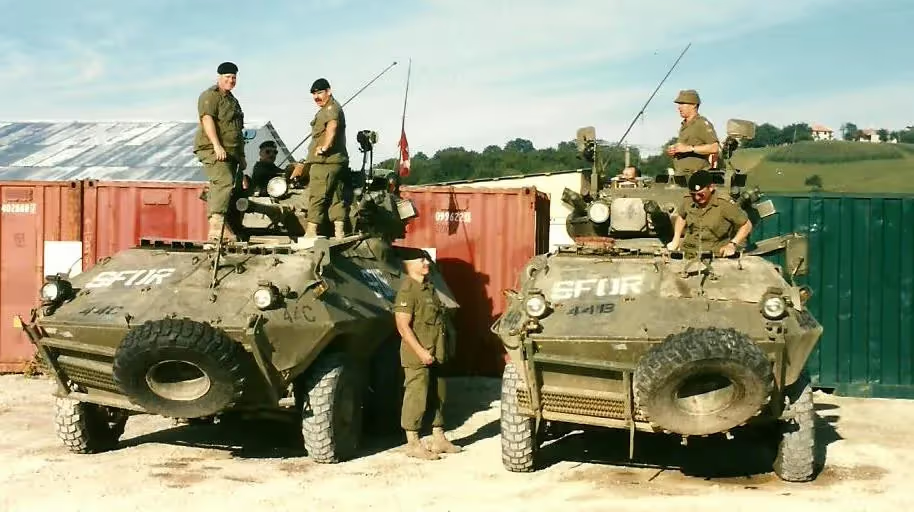
(Author Photo)
AVGP Cougar AFVs, SFOR, Velika Kladusa, July 1997.

(Author Photo)
We drove up into the mountains on Phoenix route and and noted there had been a great deal of heavy ethnic cleansing. Two Bisons on patrol were visiting the Czech Camp at Jasenica. The desolation and destruction is like a scorched earth policy similar to what one reads about in Napoleonic times. Every building, no matter how remotely situated (and this area is remote) had been destroyed. We found a UNIPTF station in Lusci Patanka sited in a town that was completely wrecked.

(Author Photo)
AVGP Cougar AFV, SFOR, Velika Kladusa, July 1997.
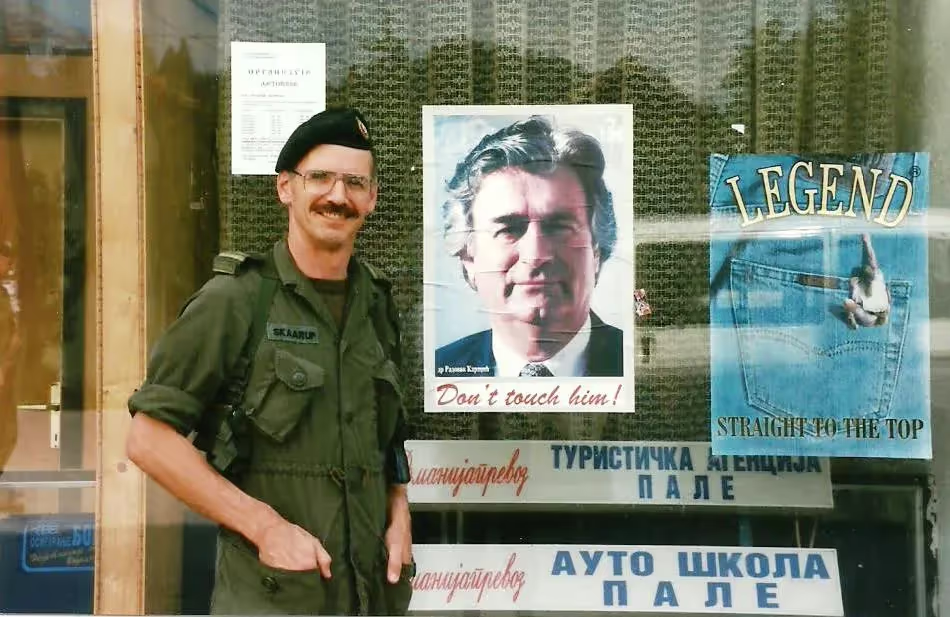
Visited the RS stronghold of Pale, some 15 km east of Sarajevo and high up in the mountains. Pale is the adopted alternate capital of the senior Bosnian indicted war criminal, Radovan Karadzic who stood in unsanctioned but de facto opposition to Madame Plavsic in the official RS capital in Banja Luka.

UK Maj Andrew Perry, UN LCol from Senegal, CA Maj Hal Skaarup, UK Maj Julian Moir, Pale, Bosnia Herzegovina.
Stopped at an IPTF station in Pale and visited the Senegalese LCol in charge. This was his 5th UN mission and he was very well spoken

(Author Photo)
View of an old stone bridge between Pale and Sarajevo.
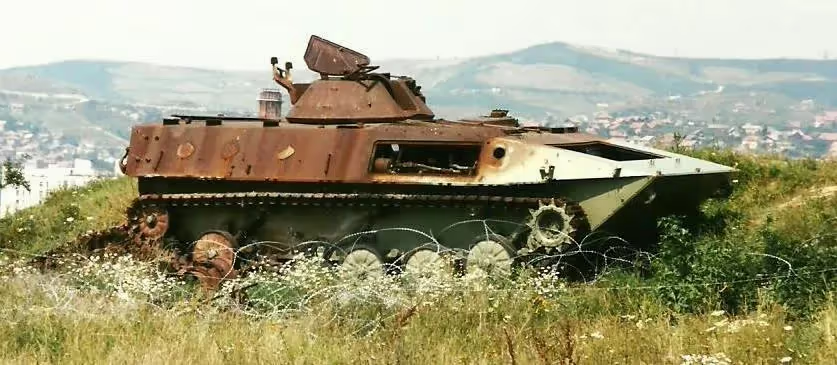
(Author Photo)
Visited the south hill and the reservoir overlooking the airport in Sarajevo. Found four shot-up BVP-M-80 APCs, tracks askew and their hulks smashed by High-explosive squash head (HESH) rounds. HESH is a type of explosive ammunition that is somewhat effective against tank armour and is also useful against buildings, fortifications and infantry.

Maj Hal Skaarup and Sgt Chris Free beside the wreckage of a BVP-M-80 APC north of Dubrovnik.
The BVP M-80 (Serbo-Croatian: Борбено возило пешадије М-80 [БВП М-80]), is a tracked Yugoslav-made infantry fighting vehicle, produced from the 1980s until the country's collapse in the 1990s.

16 Dec 97 Tuesday. Capt Bob Martyn and Sgt Ollia Kitash from the LdSH BG came down for a visit from Coralici. Took them for a tour of the battle damage in Sarajevo under a heavy snowfall. Up to the Turkish fort and out to Butmir.
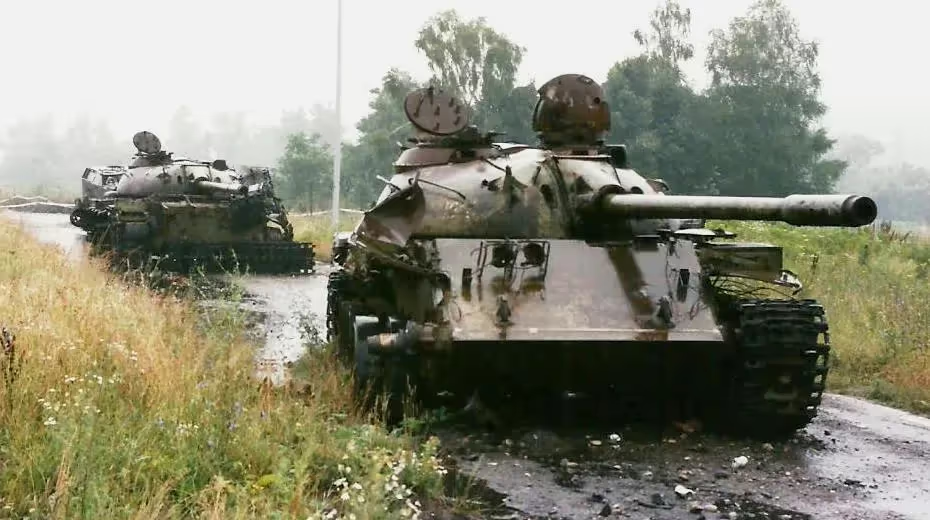
(Author Photo)
Stopped to photograph and videotape the two destroyed T-55 tanks and the wrecked BVP-M-60 APC just outside Doboj in the IEBL/ZOS.
Have feedback or a story to share?


